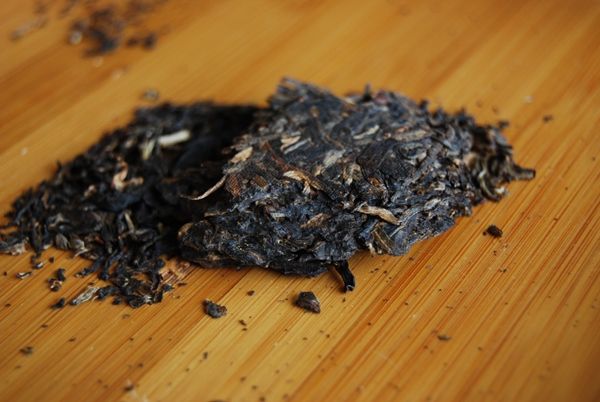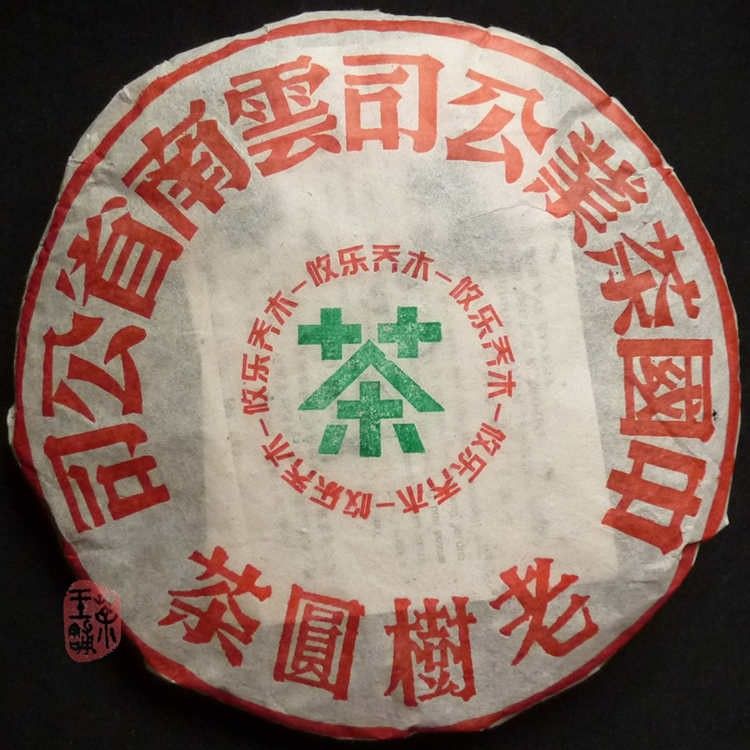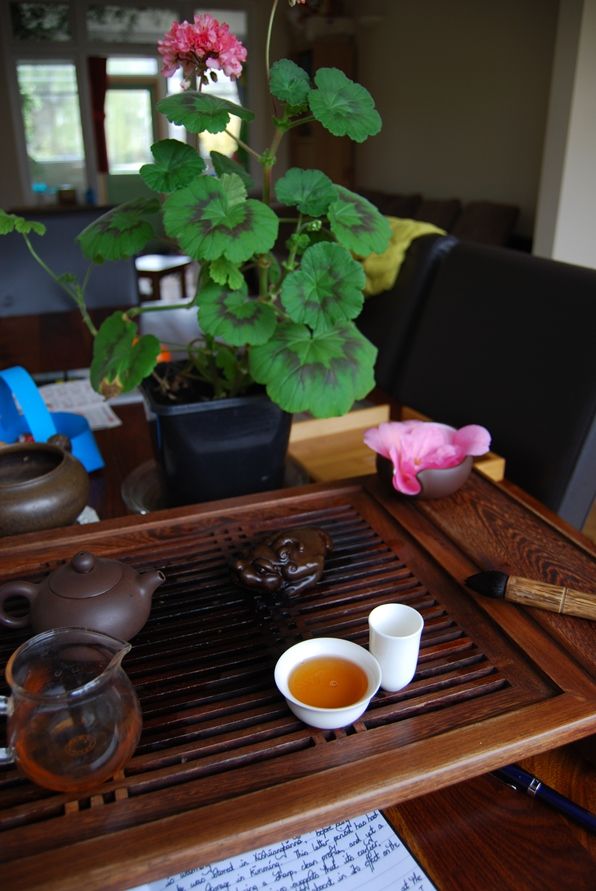Youleshan is one of the old famous mountains of Xishuangbanna. These days, it is called "Jinuoshan", named after the "Jinuo" minority (who used to be called the "Youle" minority), one of the very many minorities (in contrast to the dominant Han) encompassed by the P.R.C.
Today's article compares two Youleshan cakes, kindly provided by Jakub. (You probably read his excellent blog already.)
We start out with a cake from the "Jinuoshan Tea Co.", with whom I have no experience. Based on the evidence of this fairly shocking cake, I can't imagine myself pursuing their products with much enthusiasm...
The leaves, pictured above, are small, but have very little scent.
In the cup, it all goes woefully, terribly wrong: despite the fact that this cake is seven years old, it has a strong buttery flavour, as if it had just left the wok a few months ago. Most extraordinary is its floral, almost wulong-like floral characteristics.
Bizarreness continues as the feeling in throat is a heavy, tar-like flavour of actual molasses and strong licorice. There is very little kuwei [good bitterness], and it is hard to identify this tea with pu'ercha at all. Heaven knows how such a character could be contrived. I dread to think.
The fact that this cake, pictured below, is sold for just $37, despite its age, at Chawangshop suggests that there is an understanding that this is not the most exalted cake to reach the market. The notes on the company's web-page note a "peachy fruitiness", which could be the wulong-like floral aspects that I found.
A crazy, crazy tea.
I drank the above tea on a public holiday, and thought "I need some real tea", to continue my session. I turned to the safety of the 1998 CNNP cake from the same region.
This little fellow is sold for just $68 at Chawangshop. The compression, as you may probably deduce from the photograph above, is tight. You can make out the imprint from the hydraulic press. The leaves are small and fragmented, suggesting that this is a more down-to-earth production, in line with its reasonable price.
The leaves are so compressed that I assumed it would take a while for the soup to lift off, but the first infusion turned out to be warming and decent. Chawangshop notes that this cake was stored in Xishuangbanna, which is a decent place to keep tea, thanks to its humidity and temperature, before being moved to drier storage in Kunming. This latter period has had a noticeable effect, producing a sharp, clean profile. However, a background of rich spiciness suggests that its earlier, more humid, storage is not absent in its effect.
Perhaps expectedly, after its spicy, "red" warmth has passed, the tea becomes a little more ordinary. It fills the mouth well, and has a gently cooling sensation. While it has no real huigan [returning sweetness in the throat], it might be more fair to say that it has "huitian": a shorter sweetness, that is not the deep throaty resonance of real huigan.
I'm grateful to Jakub for this pair of teas, and particularly enjoyed the second, whose stable, warming character was welcome on a cold day.








Hello,
ReplyDeleteI wondered what you'd think of the first one. Seems that one part of people really likes it, while the other one hates it.
I quite enjoy it myself - I like the floralness and fruitiness actually. But it is unlike a lot of other puerh, that is certainly true.
I wonder what went wrong. If we meet sometime, let me brew you a bit how I usually brew it, to give it one more chance.
I thought the second one to be more ordinary - yet pleasant too, especially in the first brews.
Jakub
I have had a very, very different experience with that 2004 Jinuoshan. Are you sure you tried the spring edition of the cake? I think there is a fall one which I have heard is less than decent, but my experience with the 2004 spring (which I purchased from YS llc and was claimed to have had a few years of Bana storage) is that of a cake with some oomph,some floral notes, and a feeling that it had just moved beyond the early green and grassy stage. I have also tried the 2005 spring cake, which I think is better and stronger. I sort of here what you're saying when you talk of an oolong note to this tea, but If I pack the teapot enough I certainly get a good kuwei. It is even better with the less expensive 2005 spring cake. I am not saying that these are great cakes-- far from it. But I am saying that from my limited perspective the Bana-stored 2004 and 2005 cakes available from YS are half decent and well priced cakes that have just started to turn the corner into something deeper. Both cakes also offer a head-warming qi and yield a slightly soothing feeling. Not great cakes, by any means, but far from horrible.
ReplyDeleteBen
Ben: It is a spring harvest indeed. I've had the ones from Yunnan Sourcing too (and as they fit my tastes so well, they are a great "common" drink to me). I liked this 2004 Jinuoshan even better than the ones from Yunnan Sourcing - it is drier and feels younger, but it has certain delicate qualities which the ones from YS lack.
ReplyDeleteBtw. this 2004 Jinuo is slightly different from the one currently on Chawangshop website, it's a different batch probably.
Jakub
Dear Jakub and Ben,
ReplyDeleteIt is a rather odd thing, the Jinuo! It reminds me of burned-out cakes from minor vendors such as TeaCuppa. I've since tried cakes from later years which are similar, though which have some bitterness (kuwei); I suspect foul play on the part of the company in order to make these strange cakes "accessible"!
Toodlepip,
Hobbes
I think the production of these Jinuo Shan cakes might be a little less nefarious than you're suggesting. I think that a lot of extra buds were intentionally added to "sweeten" the tea. Bud-heavy cakes ain't everyone's cup of tea, but they are not all that unusual. I sort of doubt that a rinky-dink tea factory back in 2004 was employing oolong-like processing to make their puer'cha more accessible. Maybe, but it sounds like a lot of work.
ReplyDeleteBen
Dear Ben,
ReplyDeleteYou're quite right about yinhao (or semi-yinhao) cakes not being uncommon; they've certainly been cropping up for some years now.
As regards the processing, I understand that undercooking leaves in the wok to allow a little extra oxidation is not a modern invention. :)
Certainly, the sample I tried had been gutted. That said, Honza of Chawangshop tells me that the cake has sold out in Kunming, and is proving very popular, and so it must have its admirers!
Toodlepip,
Hobbes
Hi!
ReplyDeleteI must say that it is a big favourite around here (at least between people who visit us) - it is quite accessible even for not-that-puerhish people, yet even most puerhists enjoy it. And some people simply can't drink it. It is definitely a very good separator :)
Did I send you the Jinuoshan 2005 Red Drum? It is much more leaves than tips and it is more "puerhish". However the basic taste is rather similar.
Jakub
Dear Jakub,
ReplyDeleteYou did indeed send me the "red sun drum" - thanks! I have an article coming up with it, in fact. The bottom line was that it is clearly processed in a similar way, but is much more close to pu'ercha as we know it, and (I found it to be) much more enjoyable than the cake from this article. It has much more "oomph"!
Toodlepip,
Hobbes